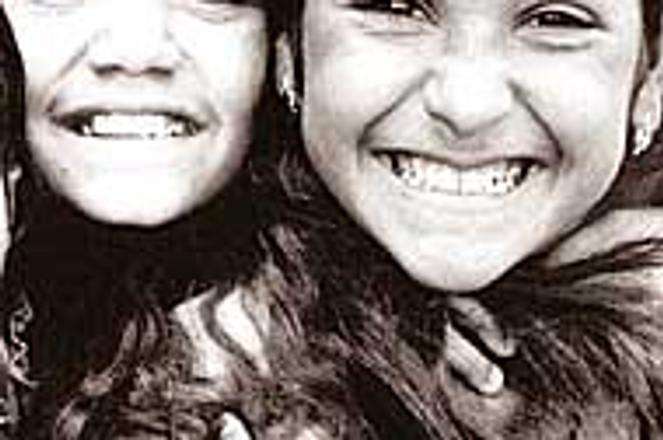DIBÁK's photos show Roma faces, not Roma poverty.photo: Miro Dibák
AS A PHOTO REPORTER for the Spišský denník regional daily, Miro Dibák used to accompany its news reporters on their assignments. Since the daily serves the eastern Slovak region of Spiš, home to some of the most squalid Roma settlements in the country, he often found himself amidst crowds of Roma, shooting their wretched living conditions with a digital camera, and wondering about the image of the Roma he was helping to create.
"As I was peering at the developed pictures, seeing masses of Roma stuck in that environment of theirs, so often abused by the media for their own purposes, I decided to tear my subjects out of it, to drag concrete individuals out of the anonymity of those settlements," says Dibák, 46.
Determined to bring a new perspective to isolated Roma communities, he started carrying a classic camera loaded with black and white film along with his digital apparatus. After taking pictures for the paper, he would mix with the crowds, take out the old camera and wait for interesting facial expressions, especially among the children.
What he emerged with, say photography experts, is a gallery of human emotions that say less about poverty than about the potential the Roma have to overcome their situation.
A selection of almost 40 black and white large-scale photographs of children that Dibák took in 2000 and 2001 in the Roma settlements of Letanovce, Rudňany and Krompachy in eastern Slovakia is now on display at the Focus Gallery in Bratislava.
"His pictures evoke an understanding of the changes this community has to undergo," says Ján Lofaj, the exhibition's curator. "And that change has to begin with the children, who simply happen to be there and don't understand their situation."
'INNOCENT faces'photo: Miro Dibák
Named after a poem from a Roma primer called O Jakha Čhavorengere (The Eyes of Children), Dibák captured the sincerity in the children's eyes, and revealed a wide spectrum of strong feeling.
In one of his photographs, for instance, three boys appear, all seeming to have a similar look on their faces. But one soon realises that each look says something different: one expresses anxiety, another happiness, and a third playfulness. Another photograph, which Dibák named "Black angel", features a small, curly-haired boy with a beautiful face. Others strain for a glimpse of bashful girls, who despite their playfulness hide from the camera lens.
Dibák knows that his pictures alone cannot solve the Roma's problems. He says he is simply fed up with seeing the Roma used only as stage props to highlight their poverty for a sensation-hungry media. Dibák's main goal was to demonstrate that the amorphous Roma population in the minds of the ethnic Slovak majority is made up of individuals, and that many of their faces, when the fog of poverty is dispelled, are strikingly beautiful.
"Dibák and [Spišský denník reporter Tomáš] Repčiak formed a perfect team. They knew how to get close to people," says Kristína Magdolénová, former chief editor for the daily and current executive director at the Roma Press Agency (RPA).
Each time they returned to a Roma village, Dibák would bring copies of the photographs he had taken during his previous visit. Magdolénová called these pictures the photographer's "tickets for entering the community".
While Dibák has never formally studied photography, he claims to have been photographically literate since childhood. Raised around professional photographers, he says, he has always regarded the skill as something natural, so much so that "I'm still really surprised when people tell me they don't know how to shoot."
'LITTLE Mowgli'photo: Miro Dibák
After failing entry exams to fine-art university, he attended the Slovak Technical University in Bratislava. Nothing, though, could dampen his enthusiasm for photography. He moonlighted at several advertising agencies and newspapers after the 1989 revolution, until Spišský denník offered him a full time job as a photo-reporter. He recently lost that post after the newspaper cut costs.
"I'm very sorry I lost the job, because it was the kind of work I always wanted to do," Dibák says. "I've applied for the same position with other newspapers, but there are fewer and fewer media in this country that can afford to have a photographer."
He explained his decision to use non-colour film to photograph the Roma as symbolising "the black-and-white view" that Slovak society takes of the minority.
RPA director Ivan Hriczko, in a speech at the exhibition opening May 7, said that Dibák's work had done much to restore human tones to the image of the Roma.
"I'm very glad that Dibák sees and shows Roma people as just like other people," he said.
What: Eyes of Children - photographic exhibition.
Where: Galéria Focus, Štúrova 9 (near the downtown Bratislava Tesco department store).
When: Open Mon-Fri 9:00-17:00 until the end of May.
Admission: Free


